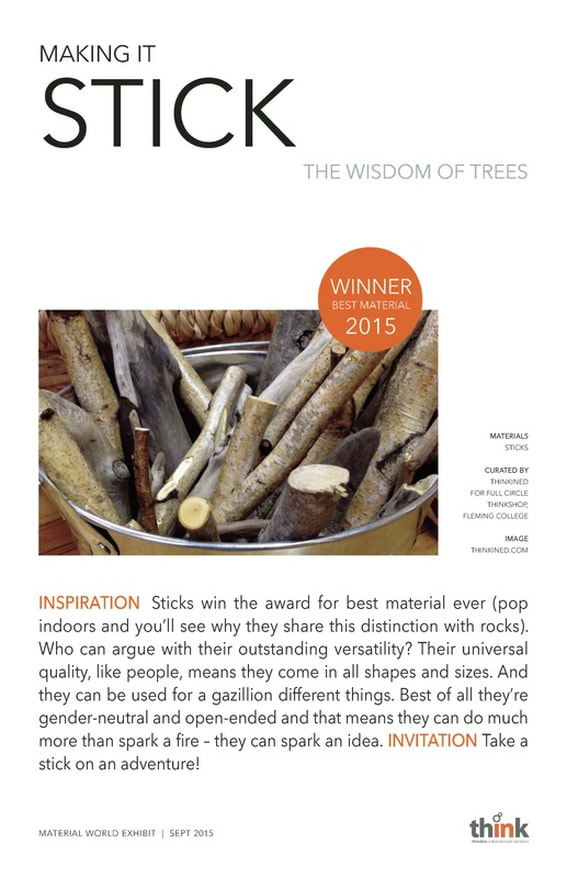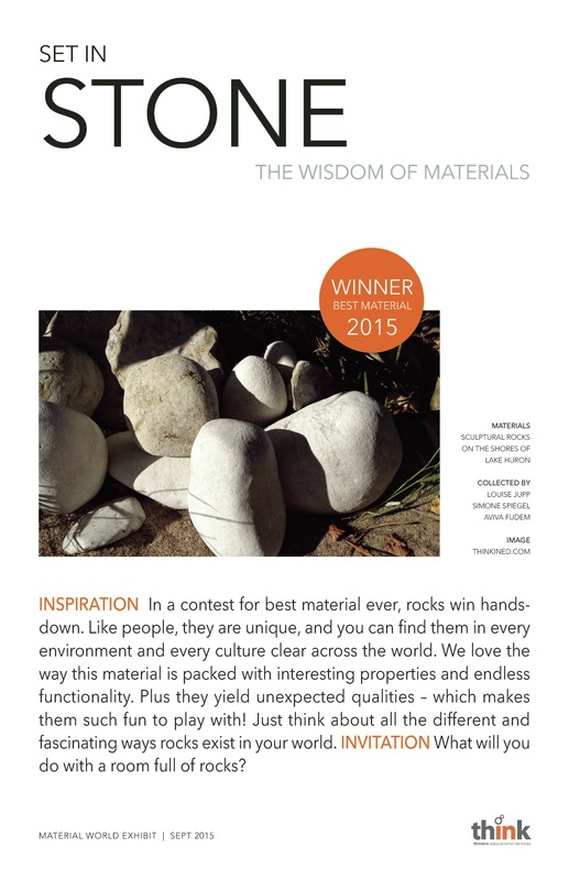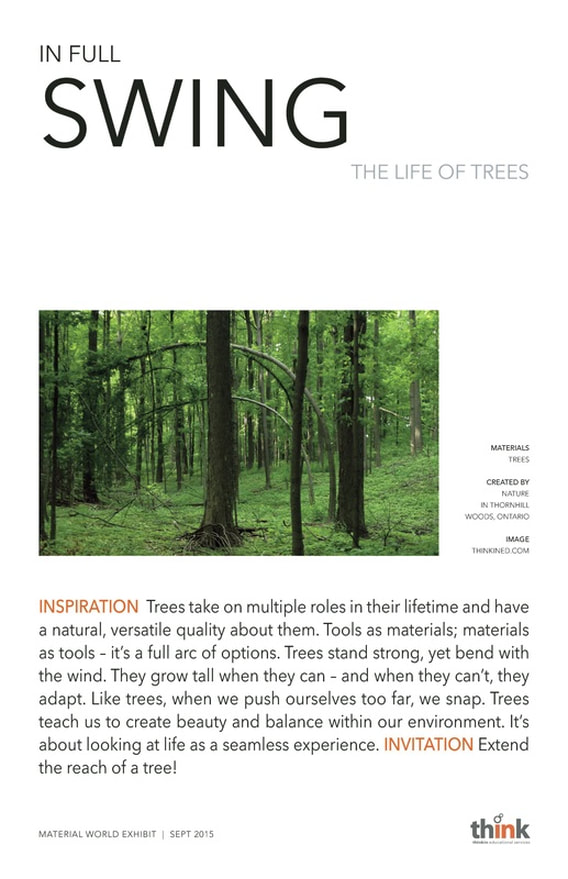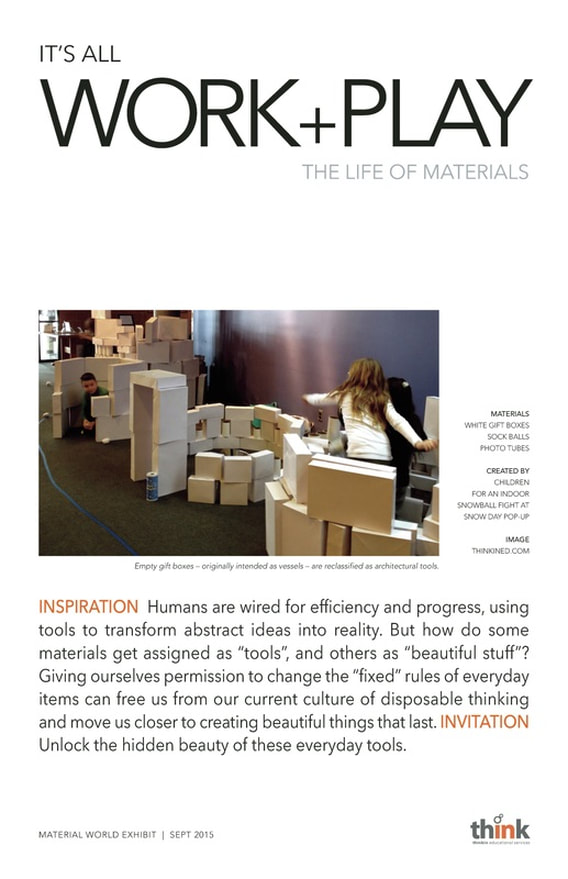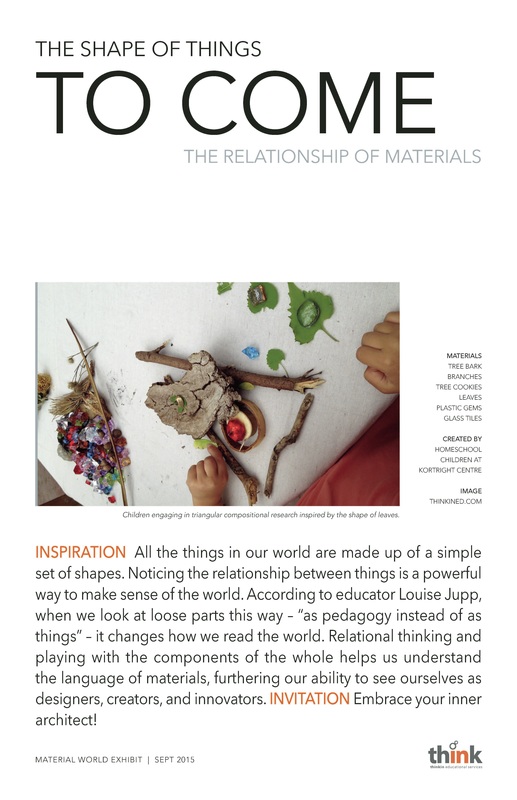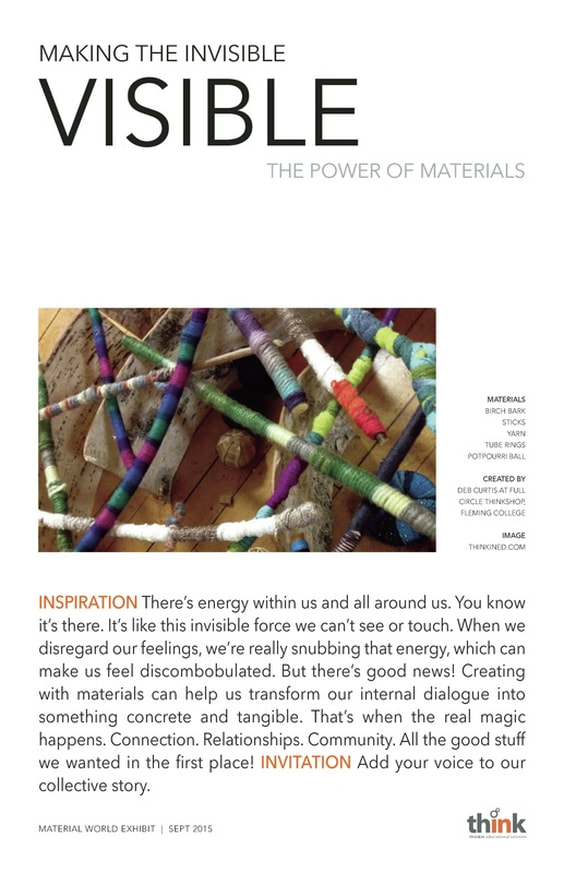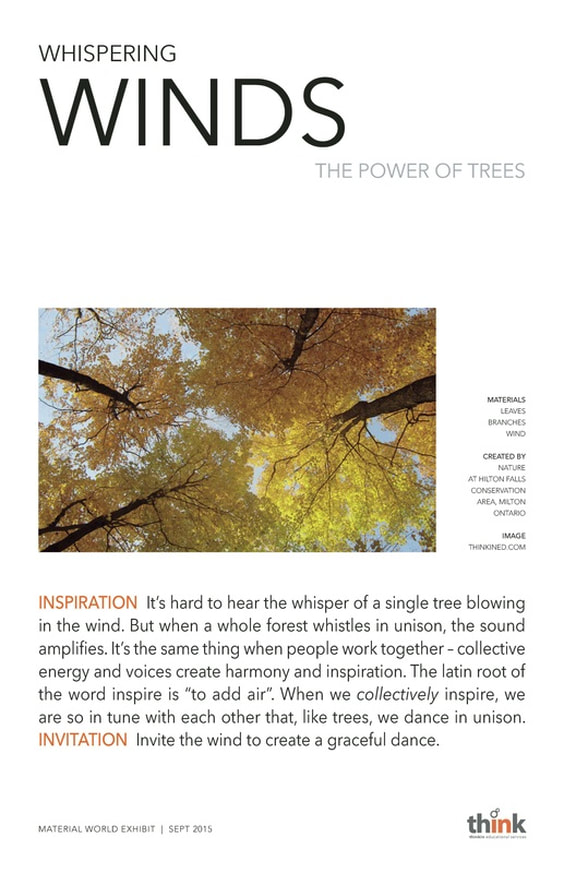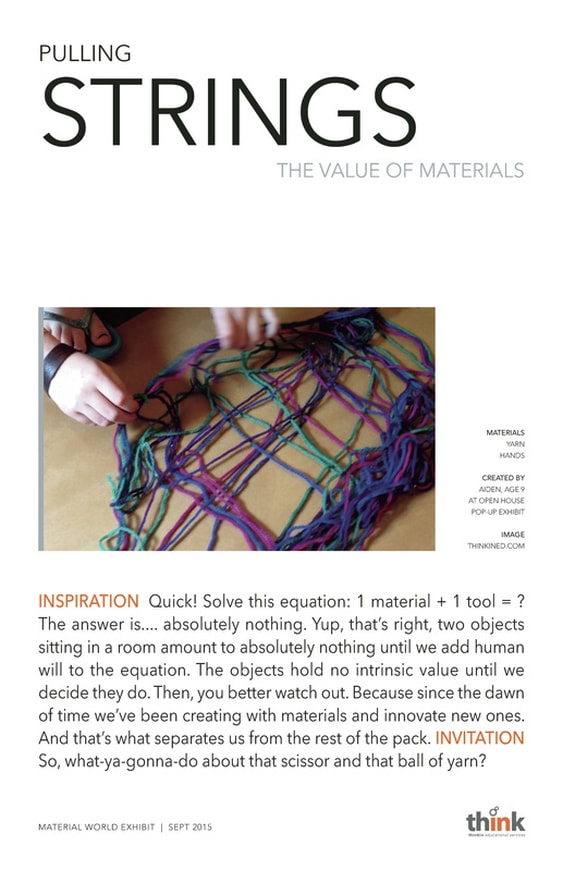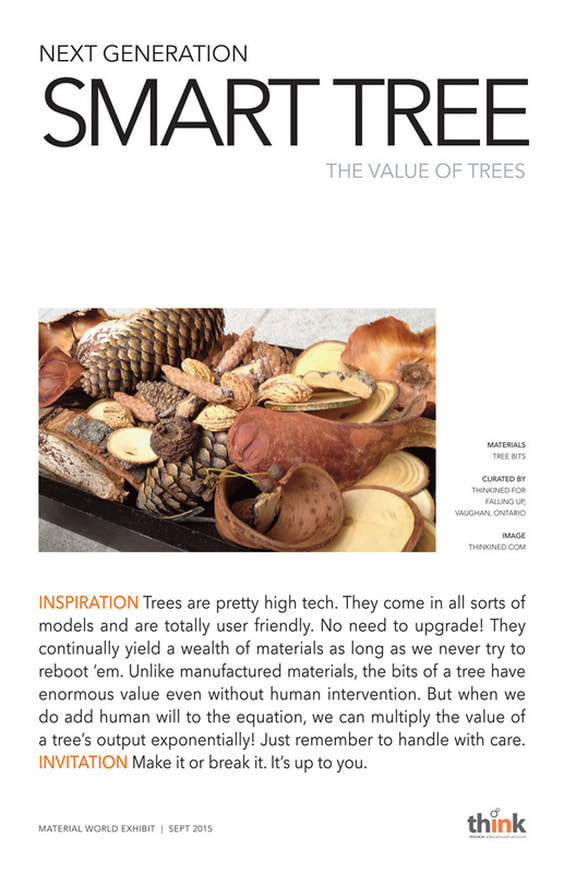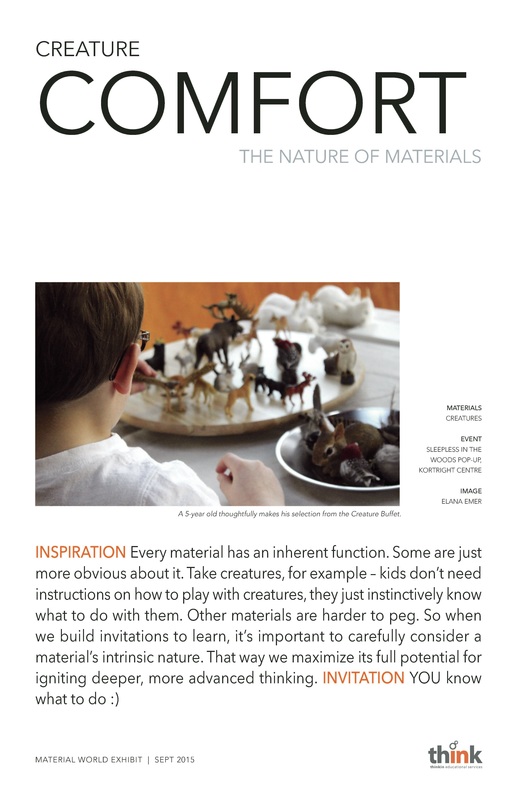Material World
JEH MacDonald House | September 2015
The wisdom of materials
|
When we first arrived at MacDonald house to build this exhibit, we came upon a large felled tree that was so out of place, it captured our imaginations and became the inspiration for the tree swing (see “the life of materials” below). Even the smallest sticks wove their way into our consciousness, as determined little hands spent hours whittling off their barks. We could witness all of these stick-related things transpire from the picture window in the Rock Room – a space solely inhabited by stones of various size, texture, and contour. As guests began to flow in and out of this installation, we noticed a distinct calming, self-regulating nature in the space. You can see in the images how people gathered to build peaceful creations – sometimes together, sometimes alone. This seemingly simple invitation to play and balance with rocks quickly became an invitation for re-balancing the mind. This installation will always hold a special place in our hearts as we suspect it will for the children and adults who shared this transformative experience. |
The life of materials
|
Both of these installations speak to the idea of generations – the generational way the materials were used, as well as the generation gaps between those who worked together. Parent and child; teacher and student; younger children pushing older children on the swing. For those five days, there was always, always someone on that swing. This was not a swing that existed before the exhibit. The branches of a downed tree willed the swing into existence (with visionary help from Diana Tucci and her skilled husband, Sandro). A fallen tree – something most would consider “dead” material – came to life in our hands as we extended its reach. A similar experience was taking place in the Work + Play installation indoors, which felt lifeless and uninviting when we opened the exhibit. No one seemed drawn to the materials. No one played. So we shared our disappointment with the educators who’d gathered for our opening night Knowledge Swap, and with their insightful input, we made some changes and the next day this room, like the tree, came to life in our hands. |
The relationship of materials
|
This room and its corresponding outdoor installation, spoke to the competence of even the youngest child’s ability to understand relationship, balance, and design thinking. Looking closely at the basic form and function of a material empowers children to discover the relationship of things. Once those connections are made we unlock our ability to think in more complex, inventive ways. The pedagogical lens of Louise Jupp crystallized many ideas for us in "The Shape of Things to Come", pushed our thinking forward, and inspired a new collection in our Cornerstore – the Designer Toolbox – an invitation to explore the language of materials. Watch the video to the left and you will see how one child playing in this space moved beyond thinking about the properties of materials, and into an exploration of movement – which ultimately became the first spark of inspiration for our next exhibit, Moving Parts. |
The power of materials
|
What can we say about this installation other than it blew us away? Lisa Nackan’s vision for this space was exceptional and more exquisite than we ever imagined. People were drawn to this experience from the very beginning. When Lisa arrived a few days into the exhibit, the collective connection we all felt to this evolving, ethereal space intensified. Even those who felt uncomfortable found ways to be in the room once Lisa arrived. But when she left at the end of that day, she felt something was missing – and went home to reflect on this. The next day Lisa returned to make peace with the missing piece! If you look closely, there are several images in this gallery where people have created “responses” to the gently swaying creations. We invite you to read Lisa's guest-blog to learn more about the power of materials to reveal our inner selves and the value of 'witnessing' what others make visible. |
The value of materials
|
It was fascinating to watch the evolution of these two installations. Indoors, a giant bowl of yarn and a pair of scissors, nothing else. Just lots of room for children to wonder – how far will it stretch? How can we knot it? First, they dressed the room. Then they dressed themselves. They began with the necessities like socks and shirts then moved on to decorative elements in their hair. They wound themselves up, then unwound themselves, testing the boundaries and limitations of this springy material. And then, when someone’s freezy accidentally dripped onto the white yarn, it led to a spontaneous inquiry about dying string. Outside, a similar exploration with the properties of wood was taking place – constructing and deconstructing all day long. What can I do with it? Can I cut it / break it / chop it / clean it / inspect its insides? There was a tool for everything, and every tool accessible to all. The children proved competent, empowered, careful, responsible. They tested and poked and explored in a very natural, non-agressive way. At Thinkin, we rarely provide materials that can be consumed or destroyed. Our goal is to challenge people to extend the life of materials – to create and re-create without permanency. So providing string and scissors, branches and axes, was a very purposeful decision. When you set out to create something permanent, what is the best material for the job? Glue in this instance would have left no room for spontaneous inquiry – the yarn would have been fixed and done. When we pay attention to the value of a material’s property, we can make choices that leave room for multiple iterations and possibilities. |
The nature of materials
|
Before you read any further, take a look through the images in this gallery and read the panel, which pretty much says it all. No child walked into this space and stopped to read the panel on the wall because no child can resist the lure of a creature waiting to play. The children who created in this space felt so at home, they set about building shelters – and even an aquascape! – for all the little creatures. Mice, snakes, dragonflies, birds – all found safe haven in the hands of these children. Only one child created differently – the boy who brought his own bag of marbles with him because his adventures with marbles at the Art of Play exhibit were so palpable and memorable for him, he needed to revisit the experience at Material World. So he created a marble run out of birch bark – reimagining that visceral experience with a whole new set of materials and challenges. |
The Knowledge Swap
|
|
Our very first Knowledge Swap was a mashup of curiosity and excitement – a rare coming together of a wonderful group of educators for an evening of meaningful conversation and enriching PD. Some were downright giddy to be amongst friends and to get a sneak-peek of the exhibit. As we made our way through the tour, several educators touched the materials, even though they weren’t supposed to. What a testament to their playful spirits that they willingly ignored our instructions! For days afterwards, we discovered little invitations they had left for others – hidden gems, secret notes, rocks with imperatives written in chalk, “listen” “stretch” “dream”.
We were struck by their constructive input, which helped us rethink the Work+Play installation and bring the space to life. We were thankful to have Louise Jupp join us at the Knowledge Swap to share her expertise on compositional research – an extension of the "Shape of Things to Come" installation, inspired by her pedagogy-in-residence. We were also grateful to Laurel Fynes, educator-in-residence from the Art of Play, who contributed to the conversation and shared her knowledge with us throughout the week. |

